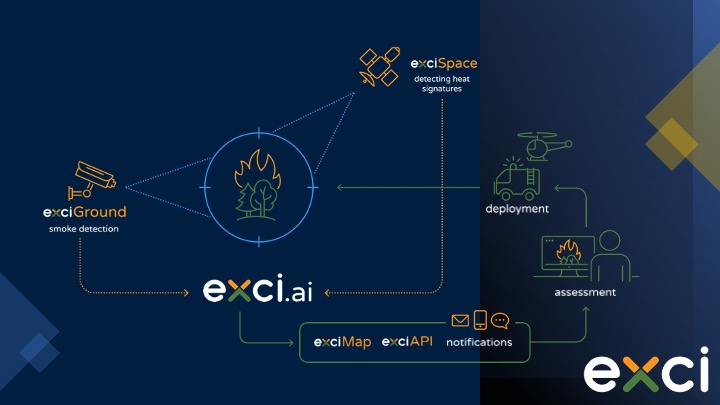Since climate-change-driven fire risks will continue to escalate, new and innovative technologies have been developed to monitor and even detect fires when they ignite. In the past, we relied on fire towers and aircraft surveillance to detect and monitor fires. Today, satellite data provides situational awareness to firefighting authorities, enabling them to make informed decisions on where to stage assets to fight forest fires.
This is possible because two NOAA scientists – Michael Matson and Jeff Dozier – made an unexpected discovery. In January 1980, they were analysing a satellite photo of the Persian Gulf when they detected tiny bright spots. The image had been captured by the Advanced Very High-Resolution Radiometer (AVHRR) on the NOAA-6 satellite. The spots they discovered were campfire-sized flares caused by the burning of methane in oil wells. This discovery was the first time such a small fire had been seen from space. Dozier and Matson were “intrigued by the possibilities” and developed a mathematical method to distinguish small fires from other heat sources within a year. Their method takes into account the intensity of the thermal radiation from the fire, as well as its spectral characteristics. This allowed them to detect fires more accurately, even in cases where the thermal radiation was relatively weak.
Matson and Dozier’s method has been used by the US Forest Service to detect wildfires from space. It has also been used by NASA to detect fires on Earth’s surface from the International Space Station. Matson and Dozier’s method is considered one of the most accurate and most uncomplicated to use, making it ideal for satellite-based fire detection systems and becoming the foundation for nearly all subsequent fire detection algorithms.
The AVHRR was the first instrument to use spectral bands that could detect fire but had a number of weaknesses which then informed the design of NASA’s Moderate Resolution Imaging Spectroradiometer (MODIS), which is aboard NASA’s polar-orbiting satellites Terra and Aqua. MODIS was designed to detect and map fires far more accurately than its predecessor AVHRR. Further improvements led to the design of the Visible Infrared Imaging Radiometer Suite (VIIRS) that is aboard the Joint Polar Satellite System’s NOAA/NASA Suomi-NPP and NOAA-20 satellites. The VIIRS sensors are of significantly higher resolution, potentially detecting fires when they are smaller depending on the time from ignition to when the area is imaged. VIIRS also has improved the mapping of large fire perimeters and better nighttime fire detection capabilities through its day-night band, which can measure low-intensity visible light emitted by small and fledgling fires.
If a polar-orbiting satellite overpasses the location of a fire, its sensors will detect the fire’s emitted energy. The sensors transmit the fire data to the ground stations via radio waves. The data is processed and then analysed by fire detection algorithms for a thermal anomaly indicating heat signatures, which could be a fire or any other heat source. The approximate location of a hotspot (centre of approx. 1 km2 area) is plotted, with imagery generally accessible within four to five hours of satellite observation. Fire crews and wildland managers are informed within 3 hours of the fire detection and the approximate location of a potential wildfire or hotspot.
The Advanced Baseline Imager (ABI) Fire Detection and Characterization Algorithm (FDCA), which has been initially based on the WFABBA, processes data from the geostationary satellite GOES-16. Eight of the ABI’s spectral bands can detect smoke, nighttime fires, hot spots, and burn scars.
Bear in mind that only the satellite systems of NASA, NOAA and Metop are equipped with fire detection algorithms and the necessary distribution processes. The collected fire data is available for free on a global scale. Unfortunately, however, the majority of the operating satellites observing the Earth are not set up for fire detection.
In Australia, the data of hotspots are transmitted by the geostationary satellites HIMAWARI-8 and -9 and the polar-orbiting satellites Terra, Aqua, NOAA-19, Suomi NPP and JPSS-1 (NOAA-20). The HIMAWARI satellites take a full scan of the coverage area every 10 minutes. However, processing the hotspot data can take between 30 minutes to several hours.
Since the revisit time of polar-orbiting satellites could be several hours to as much as 5 to 10 days, the potential to detect wildfires early is significantly low. In addition, not all satellites have imaging instruments on board, and currently, no satellite has been designed specifically for rapid fire detection.
Yet, a key determinant of whether a fire turns into a large and devastating fire is the time between ignition, detection, and first attack response. Every minute counts! Detecting fires early enables firefighting agencies to attack, contain and extinguish fires rapidly.
Although satellites have the advantage of providing 24-hour detection coverage, they are significantly slower in detecting fires than ground-based cameras. While cameras can detect smoke from about 25 km (most efficient from 15 to 25 km) away, satellites can sense the heat from fires, especially at night. Satellites are also less affected by the topography and can help with mapping wildfires. In addition, installing multiple rotating cameras in high-risk areas allows 360-degree monitoring and triangulating the location of a fire. Therefore, combining ground-based camera data with satellite imagery is the best approach to enhance the result.
However, monitoring many cameras requires dedicated staff who constantly and diligently look at live image streams to detect fires manually. Apart from being costly, maintaining attention when performing monotonous tasks such as looking at very slow changing images for many hours is difficult. The answer to this problem is to leverage the power of AI technologies.
Using AI to detect Bushfires early
Artificial intelligence (AI) is one of the most promising technologies to help with bushfire detection, prediction, and risk assessment.
An automated system that utilises advanced AI can detect fires more rapidly than humans because it has the ability to analyse ground-based camera and satellite data much faster and precisely, which can help us make better and more informed decisions.
exci’s proprietary cutting-edge artificial intelligence models are built on deep machine learning algorithms that have been trained on more than a billion camera images and over 500,000 satellite images per year, resulting in unrivalled accuracy and speed. The geostationary satellites used by exci focus on detecting heat signatures but are mainly used for remote areas. Whilst the ground-based camera system provides fast detection during the day, geostationary satellites are better suited for remote and broad area coverage, night-time detections, and to provide comprehensive coverage in all weather conditions.
exci does not use polar-orbiting satellites for rapid bushfire detection because they are unable to provide real-time detections due to their high revisit times. However, exci utilises polar-orbiting satellite data for wildfire tracking and mapping.
exci detects wildfires automatically within minutes by combining satellite and ground-based camera data that are analysed by powerful deep machine learning algorithms (artificial intelligence) for the presence of smoke and heat. Even small fires are automatically detected within minutes after ignition, with a near-zero rate of false positives.
The effectiveness of exci’s technology was demonstrated in California, using data from nearly 1,000 cameras covering over 125 million acres of land in California. exci also has commercial deployments in Australia, protecting over 2 million hectares of plantations and forestry in QLD and NSW.
Amazon Web Services supports exci in its efforts to fight wildfires. At the first re: Mars event in Las Vegas in June 2022, AWS represented exci’s early wildfire detection system. Check out the report from Channel 9 Today show!
exci’s AI-based system for wildfire detection is invaluable, as it can help to quickly identify and respond to fires, minimising the social, environmental, and economic impact caused by wildfires.
by Gabrielle Tylor
exci
Early Bushfire Detection and Notification Service
Read more:
Part 1: Satellites in Space – Watching over our Planet
Part 2: History of Environmental Satellites
Part 3: Satellites Limitations in Early Wildfire Detection

